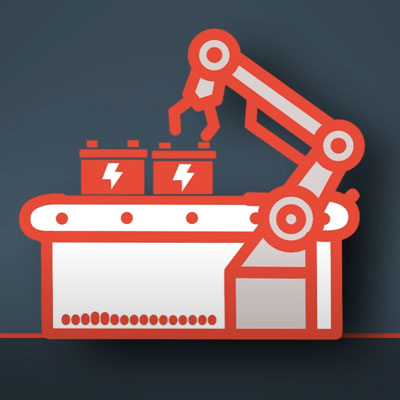Build better batteries: Part 1
Battery projects are failing. Here's how to fix them.
Why are battery projects failing—and what can we do about it? Discover the root causes and the path forward in Part 1 of the Build Better Batteries video series.
The evolution of battery materials and cells projects has so far been distinguished by waves. The first wave saw Asia developing its battery manufacturing capacity. The second wave involved the initial transfer of that technology to Europe and North America, where projects encountered failures due to cost overruns and delays.
These waves are characterized by invention and industrial use, early research and breakthroughs, industrial scale-up and innovation, and integration and circularity.
While these trends paint a compelling picture, their true value lies in considering that they’ve been refined by two types of battery project developers: those with mature processes that work well in Asia who attempt to transfer technology to Europe and America, and newcomers who introduce innovative process technologies and chemistries to emerging markets.
Riding the wave
After five years of sobering outcomes for builders and investors, the impact of tariffs on business confidence and project costs has led to even greater investor hesitation. Industry experts rely on predictable outcomes; fluid public policy and the inability to accurately calculate the effect of tariffs on inflation is driving investors and builders to hit the brakes.
But a third wave of investment will emerge, and those who succeed will be those who pursue projects with confidence and intelligent planning.
“This is merely a period of upheaval. Circumstances will likely improve, leading to renewed investment.”
Battery technologies are now central to the energy transition, acting as critical infrastructure for electrified transportation, grid resilience, and decarbonization. For those building the materials supply chains, scaling cell production, and closing the loop through recycling, the mandate is clear: we must deliver performance, scale, and sustainability—simultaneously.
Global EV adoption is still growing and annual sales in western markets are conservatively expected to double within five years, while grid-scale storage is simultaneously emerging as a critical buffer for renewable energy. This twin demand is driving unprecedented investment in cell manufacturing capacity and materials supply chains. For materials and cells producers, this means expanding capacity while improving energy density, life cycle, and safety without sacrificing cost competitiveness.
Meanwhile, regionalization is becoming strategically imperative; for manufacturers and recyclers alike, resilience is now as important as scale. Geopolitical tensions and pandemic-era disruptions highlighted the vulnerability of global supply chains, driving the charge toward regionalized battery ecosystems, particularly in North America and Europe. This includes investments in domestic critical minerals, precursor materials, and cathode/anode production.
NMC chemistries remain dominant in high-performance applications, while LFP resurged due to cost and safety advantages. Sodium-ion, lithium metal anodes, and lithium-sulfur chemistries are moving from labs to pilot lines. Solid state platforms also continue to capture the attention of industry due to safety benefits, but sustainable performance still needs to be proven.
We must ensure we get it right; otherwise, we risk jeopardizing the opportunity to establish a strong lithium-ion battery manufacturing industry in the west.
Ride the tide toward an integrative strategy
We’ve identified recurring challenges that can erode the business case for large-scale projects, and in some cases, lead to complete failure:
- Rushing the schedule at the expense of due diligence. In the drive to stay on schedule, critical steps are often overlooked, especially with emerging technologies that have yet to be commercialized. Skipping foundational work creates significant risk downstream.
- Underestimating project complexity. These are not simple construction projects; they’re large-scale, integrated systems with extensive scopes. Oversimplifying the effort (e.g., “it’s just a building”) leads to gaps in planning and resourcing. Success requires a deep understanding of how all components work together seamlessly.
- Insufficient planning and lack of control. When proper planning is lacking—and compounded by ongoing design changes aimed at improving performance—projects can quickly spiral. The result: cost overruns, schedule delays, and a loss of control. Often, clients become so committed to their project development partners and sunken costs that they feel forced to stay the course, hoping the project will eventually be completed and operational.
- Inadequate preparation for operations. In some cases, plants have been replicated from international designs (e.g., copy/paste from Asia to the US) without sufficient adaptation. These facilities struggled for years to reach stable production—let alone profitability. Operational readiness requires more than equipment installation; it demands well-trained operators, effective systems, and robust support infrastructure.
What's next?
In recent months, there has been a slowdown in electric vehicle (EV) sales. Many of the lithium-ion plants that were constructed are not operating at full capacity due to insufficient demand.
The primary issue is the cost of EVs and their overall affordability. While we need to acknowledge these challenges, we also believe that this is merely a period of upheaval and that circumstances will likely improve, leading to renewed investment.
In fact, this pause may have a silver lining: an opportunity to enhance our strategies for when the next wave of demand arrives.
The wave won’t be led by organizations that scale the fastest—but by those that scale intelligently. Materials development, cell project delivery, and recycling integration must be considered holistically from mine to module, from lab to life cycle.
Build Better Batteries is a market study on recent battery materials and cells project failures. It offers solutions grounded in venture success.

